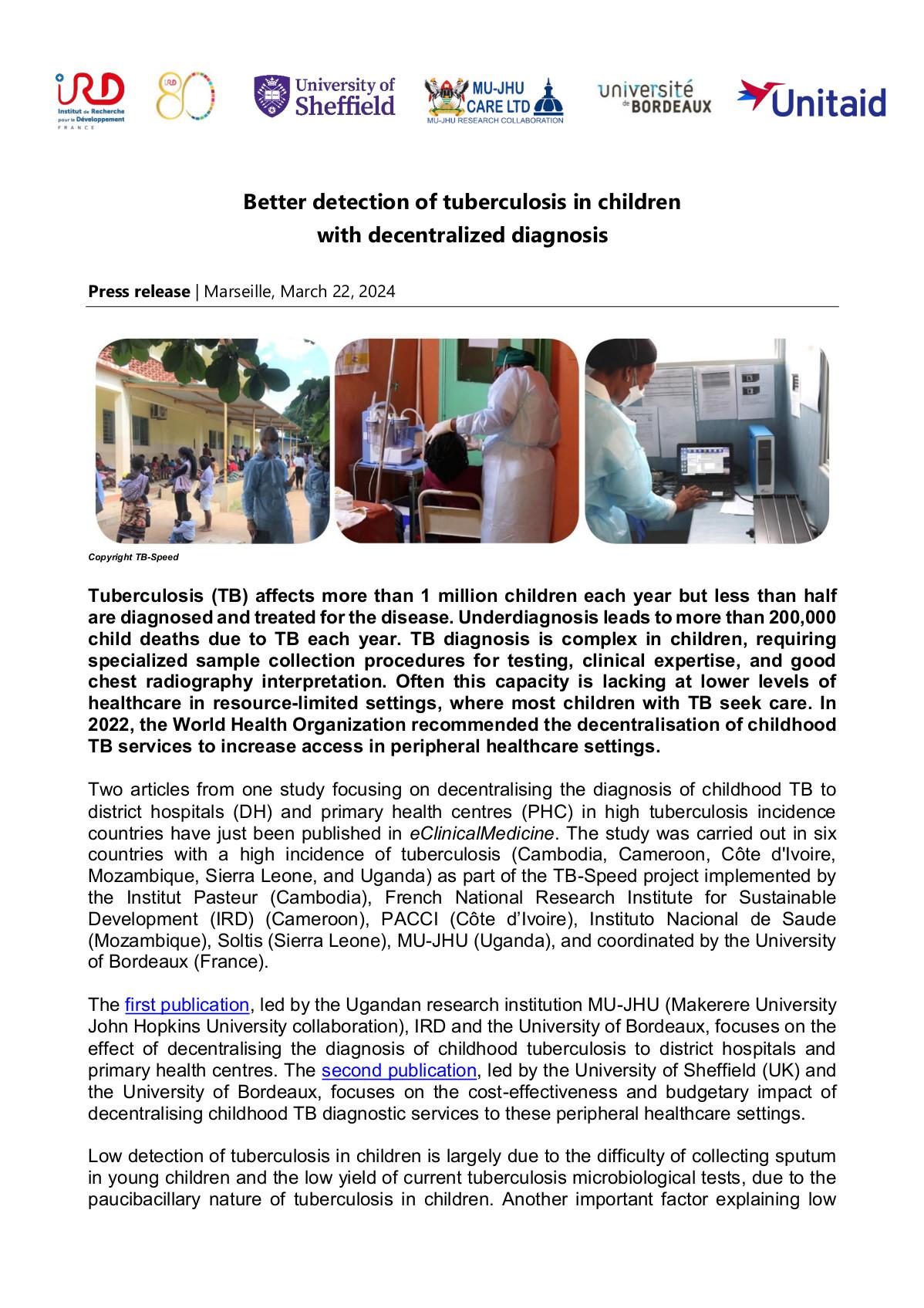PRESS RELEASE: Decentralising the diagnosis of childhood tuberculosis to district hospitals and primary health centres in high tuberculosis incidence and resource-limited countries
Retour
Decentralising the diagnosis of childhood tuberculosis
to district hospitals and primary health centres
in high tuberculosis incidence and resource-limited countries
Two articles from one study focusing on decentralising the diagnosis of childhood TB to district hospitals (DH) and primary health centres (PHC) in high tuberculosis incidence countries have just been published in eClinicalMedicine. The study was carried out in six countries with a high incidence of tuberculosis (Cambodia, Cameroon, Côte d’Ivoire, Mozambique, Sierra Leone, and Uganda) as part of the TB-Speed project implemented by the Institut Pasteur (Cambodia), French National Research Institute for Sustainable Development (IRD) (Cameroon), PACCI (Côte d’Ivoire), Instituto Nacional de Saude (Mozambique), Soltis (Sierra Leone), MU-JHU (Uganda), and coordinated by the university of Bordeaux & GHiGS team.
The first publication, led by the Ugandan research institution MU-JHU (Makerere University John Hopkins University collaboration), IRD and the university of Bordeaux, focuses on the effect of decentralising the diagnosis of childhood tuberculosis to district hospitals and primary health centres. The second publication, led by the University of Sheffield (UK) and the university of Bordeaux, focuses on the cost-effectiveness and budgetary impact of decentralising childhood TB diagnostic services to these peripheral healthcare settings.
Tuberculosis (TB) affects more than 1 million children each year but less than half are diagnosed and treated for the disease. Underdiagnosis leads to more than 200,000 child deaths due to TB each year. TB diagnosis is complex in children, requiring specialized sample collection procedures for testing, clinical expertise, and good chest radiography interpretation. Often this capacity is lacking at lower levels of healthcare in resource-limited settings, where most children with TB seek care. In 2022, the World Health Organization recommended the decentralisation of childhood TB services to increase access in peripheral healthcare settings.
Low detection of tuberculosis in children is largely due to the difficulty of collecting sputum in young children and the low yield of current tuberculosis microbiological tests, due to the paucibacillary nature of tuberculosis in children. Another important factor explaining low
detection of TB in children is the design of health systems. Childhood tuberculosis services are mostly centralised at high levels of care, inaccessible to most children living in high incidence and resource-limited countries. Child-adapted respiratory specimen collection methods and rapid molecular testing are often lacking at lower levels of healthcare. Chest X-ray, a useful tool for diagnosis of non-microbiologically confirmed tuberculosis, is often only available at referral hospitals and hampered by poor quality of X-rays and lack of training on interpretation for children who may have TB. In addition, there is often low awareness of childhood TB and lack of confidence in making a clinical diagnosis among healthcare workers at low health system levels. There is, so far, little evidence on what, how, and where to decentralise childhood TB diagnostic capacity.
Recent advances in diagnostic approaches could contribute to improved childhood TB diagnosis at low levels of care. Training and clinical mentoring could build confidence in healthcare workers to initiate treatment without microbiological confirmation.
& access to the press release
IRD : Charlotte Gabet – presse@ird.fr



